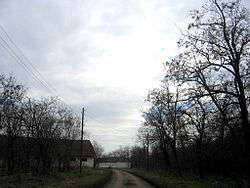Stajićevo camp

The Stajićevo camp (Logor Stajićevo) was an agricultural farm in Stajićevo near Zrenjanin, Serbia (then part of SFR Yugoslavia, then FRY) where Croatian prisoners of war and civilians were kept by Serbian authorities.[1] The camp also acted as a transit facility where prisoners fwere taken before being moved to the Sremska Mitrovica camp. Individual reports have said that 1500 people were held there.[2] The ICTY's figure for the camp was 1700 detainees.[1]
The camp was cited in the International Criminal Tribunal for the former Yugoslavia's case against then Serbian president Slobodan Milošević.[1] Goran Hadžić is also indicted on charges by the ICTY related to the camp.[3]
Prisoners at the camp included future Croatian parliamentarian Ivica Pančić's father and brother.[4]
Conditions at the camp
Former prisoners at the camp reported being beaten, with at least one claiming to have received electric shocks by guards.[5] According to reports, the White Eagle paramilitary was also active at the camp.[2]
According to the reports, the age of the detainees ranged from 8 to 80. At least 17 people were killed in the camp.[5] The conditions in the camp were generally poor: people had to sleep on the concrete floor in November on their first day in the camp, but were later given a blanket. In the first 10 days, they received only two meals a day, mostly tea and bread with cheese. There were also no toilets in the farm, so the detainees had to relieve themselves on the floor. After 10 days, latrines were finally added in the camp. After five days, they were given water to wash themselves.[6]
The Yugoslav People's Army officers in control of the camp expected all detainees to be Croats, so when one of them recognized a Serb detainee, one Aleksandar Jevtić, they showed them lenience and offered to move them to a separate part of the facility. Jevtić in turn decided to report several of his Croat friends as Serbs in order to help them, an act for which he would later be decorated by the Croatian President.[7]
Detainees were released in a prisoner exchange in January 1992, after spending over three months in the camp.
References
- 1 2 3 The Prosecutorof the Tribunal Against Slobodan Milosevic
- 1 2 Final report of the United Nations Commission of Experts established pursuant to security council resolution 780
- ↑ Goran Hadzic - Indictment
- ↑ Nacional, interview with Ivica Pancic, the new Croatian Minister for War Veterans' Affairs, 7/21/00
- 1 2 Final report of the United Nations Commission of Experts, established pursuant to security council resolution 780 (1992), Annex VIII - Prison camps; Under the Direction of: M. Cherif Bassiouni; S/1994/674/Add.2 (Vol. IV), 27 May 1994, Annex VIII: Prison camps (part 10/10), (p. 5916-6043). Accessdate 17 October 2010..
- ↑ Yugoslavia – further reports of torture, Amnesty International, March 1992. p. 15. Accessdate 17 October 2010.
- ↑ "Naša domovina - I Jovan je branio Hrvatsku". Slobodna Dalmacija (in Croatian). 26 October 2009. Retrieved 17 September 2011.
External links
Coordinates: 45°16′29″N 20°28′01″E / 45.27472°N 20.46694°E
